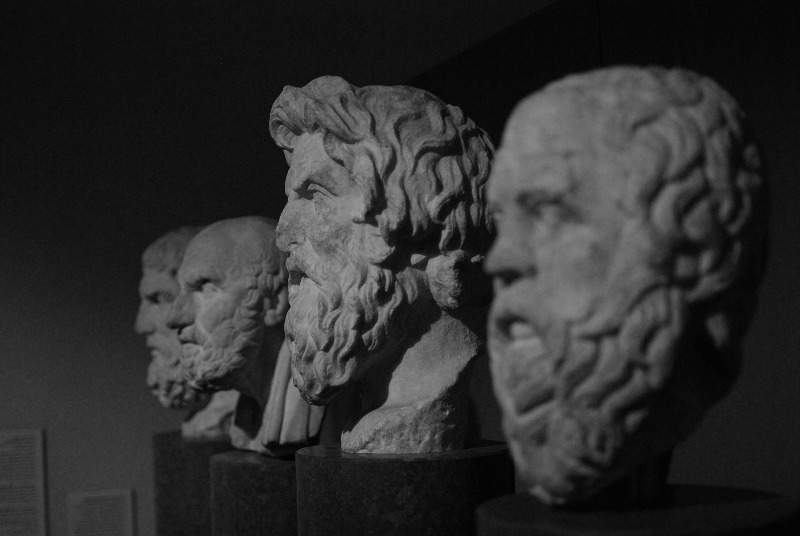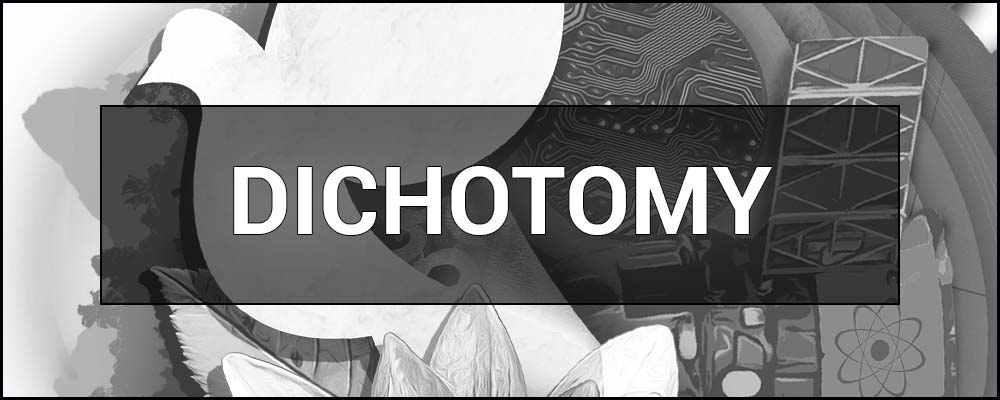A dichotomy is the opposition of two things that are completely opposite or radically different from each other. The term “dichotomy” comes from the Greek word “dichotomia,” which means “cutting in half”.
What is DICHOTOMY — definition and meaning in simple words.
In simple terms, a dichotomy is a concept that means to separate or contrast two things that are completely opposite and have nothing in common. It is also a useful tool for simplifying complex concepts and making them easier to understand. In a dichotomy, the two parts are often presented as mutually exclusive and exhaustive, meaning that there is no middle, consensus or third option. For example, the dichotomy of opposing good and evil is a common theme in many religions, beliefs, and philosophies. Another example is the dichotomy of good and evil, which is used in ethics and law.

Dichotomy – Synonyms:
Synonyms for the word “dichotomy” in English: Division, Separation, Contrast, Binary, Duality, Split, Opposition, Two-sidedness, Dualism, Dichotomization.
What is dichotomy in philosophy?
Dichotomy plays an important role in philosophy. Many philosophical concepts and ideas have been simplified through the use of this tool.
One of the most famous examples is the mind-body dichotomy, which has been debated for centuries. Other common dichotomies in philosophy include the opposition of reason and emotion, free will and determinism, and the dichotomy of idealism and realism.
However, some established philosophers have argued that dichotomies can limit our understanding of complex issues and may not accurately reflect the complexity of philosophical concepts. Despite these criticisms, dichotomies continue to be an important tool for simplifying complex philosophical ideas and concepts. This, in turn, makes them more accessible to a wider audience.
What is dichotomy in science?
Dichotomy in science is, as in philosophy, an important tool that is used to simplify complex scientific concepts by separating them into two opposing sides. This technique is often used in various scientific fields, including genetics, psychology, and research methodology.
The clearest example of the dichotomy in science is the “human nature vs. nurture” debate. In this case, it examines the extent to which genetics and environmental factors influence direct human behavior. Other dichotomies in science include hypothesis and theory, quantitative and qualitative data, empirical and theoretical research.
Although, as in philosophy, some scientists criticize dichotomies for oversimplifying complex issues, they allow scientists to translate complex concepts into more understandable terms, making scientific research accessible to large numbers of people.

What is dichotomy in everyday life?
Dichotomies are not limited to the academic or scholarly context. It also has a significant impact on our daily lives. We often use dichotomy in everyday conversations to divide people, objects, and concepts into two different groups. For example, we often divide people into introverts and extroverts, good or bad, right or wrong. In the world of politics, people often identify themselves as leftists or rightists, liberals or conservatives, communists/socialists or democrats, and so on. Dichotomies also play a role in our consumption habits, as we often divide products into luxury and budget, healthy and unhealthy, environmentally friendly or not.
Types of dichotomies.
There are many types of dichotomies that are used in different industries. Here are some of the most common types:
- Binary dichotomy: this is the simplest form of dichotomy, where concepts are divided into two opposite and mutually exclusive categories, such as black or white, male or female, hot or cold.
- Hegelian dichotomy: this is a type of division in which the opposing sides are not mutually exclusive, but rather complement each other to form a unified whole. This concept is often used in philosophy and is based on the idea of thesis and antithesis, which ultimately leads to synthesis.
- Dualistic dichotomy: This is the type that assumes two opposing forces in a constant struggle for dominance, such as good versus evil or reason versus matter.
- Quantitative: is a type of dichotomy that categorizes things based on numerical values, e.g., high or low, big or small, fast or slow.
- Qualitative: is a type of division that classifies things based on subjective qualities, such as beautiful or ugly, tasty or disgusting, good or bad.
- Epistemological: This is the type that refers to how we acquire knowledge. It often includes two opposing approaches, such as rationalism versus empiricism or objectivity versus subjectivity.
- Methodological: This is a type of dichotomy that refers to different approaches to research or problem-solving. Examples include qualitative and quantitative research or deductive and inductive reasoning.
- Cultural dichotomy: This is a type of dichotomy that reflects a society’s cultural values or beliefs. Examples include collectivism versus individualism or traditional versus modern values.
- Moral dichotomy: This is the type that involves opposing moral values or principles, such as justice versus mercy or freedom versus security.
- Psychological dichotomy: This is an oppositional dichotomy related to human psychology and personality characteristics. Examples include introversion and extraversion, or thinking and feeling.
- Political dichotomy: is a type of dichotomy that reflects opposing political ideologies or political systems. Examples include democracy versus dictatorship or socialism versus capitalism.
- Biological dichotomy: This is an oppositional dichotomy that deals with differences between the sexes or genders in biology. Examples include male and female chromosomes or XX and XY chromosomes.
- Economic dichotomy: This is a type of dichotomy relating to economic systems and theories. Examples include free market vs. planned economy or Keynesian economics vs. Austrian economics.

Advantages and disadvantages of dichotomies.
While dichotomies can be a useful tool for analysis and understanding, they are not without disadvantages.
Here are some of the advantages and disadvantages:
Advantages:
- Clarity: Dichotomies can provide a clear distinction between two opposing concepts, making it easier to understand and analyze complex ideas and concepts.
- Simplification: Dichotomies can simplify complex ideas by breaking them down into binary opposites.
- Identifying patterns: Dichotomies can help identify patterns in data, making it easier to classify and analyze large amounts of information.
Disadvantages:
- Oversimplification: Dichotomies can be oversimplified, hiding the complexity and nuances of certain concepts and phenomena.
- Incompleteness: Dichotomies may not cover the full range of possibilities or options available, resulting in a limited understanding of a particular subject.
- Reductionism: Dichotomies can lead to reductionist thinking, where the complexity and variety of a subject is reduced to a single binary opposition.

Examples of dichotomies in society and culture.
Dichotomy is not just a philosophical or scientific concept; it also plays a significant role in our society and culture. Here are ten examples of dichotomies in society and culture:
- Good vs. Evil: One of the most famous dichotomies, good vs. evil, is present in many religions, myths, and stories.
- Nature vs. nurture: This refers to the debate over whether our behavior and personality traits are a product of our genetics or the environment in which we grew up.
- Traditional vs. modern: This dichotomy concerns the contrast between maintaining traditional values and embracing the modern way of life and existing paradigm.
- East vs. West: This dichotomy describes the cultural differences between Eastern and Western societies.
- Man and Woman: This dichotomy reflects the traditional binary gender roles that have long dominated our society.
- Freedom or Control: This contrast describes the tension between the desire for personal freedom and the need for social control.
- Public or Private: This dichotomy describes the difference between what is considered acceptable in society and what is considered acceptable in private life.
- Wealth and Poverty: Reflects the economic inequality that exists in our society.
- Health and sickness: emphasizes the contrast between a healthy body and a sick body.
- Mind or body: Refers to the debate over whether mind and body are separate entities or are interrelated.

Conclusion:
- Conclusion on dichotomy: In this article, we have looked at the concept of dichotomy, which refers to the division of something into two separate categories or parts. We have discussed how this idea is applied in various fields, including philosophy, science, and everyday life.
- Types of Dichotomies: We looked at several types of dichotomies, particularly false dichotomies, nominal and real dichotomies, value and non-value dichotomies. Each type has its own unique characteristics and can be useful or problematic in different contexts.
- Advantages and disadvantages: We have looked at advantages, such as providing clarity and simplification, and disadvantages, including oversimplification and exclusion.
- Examples in Society and Culture: We gave several examples of dichotomies in society and culture, including gender, race, and political ideologies. These examples demonstrate how dichotomies can be both helpful and harmful in shaping our understanding of the world around us.
- Final thoughts: In conclusion, dichotomies are powerful tools that can be used to categorize and simplify complex ideas. However, it is important to be aware of its limitations and potential drawbacks. By understanding the different types of dichotomies, their advantages and disadvantages, we can make informed decisions about when and how to use the concept effectively.




